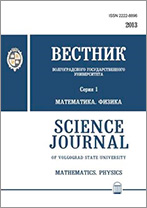|
|
Vestnik Volgogradskogo gosudarstvennogo universiteta. Seriya 1. Mathematica. Physica, 2014, Issue 5(24), Pages 6–23
(Mi vvgum19)
|
 |
|
 |
Mathematics
On the structure of the boundary of the set of stability of a certain multi-parameter Hamiltonian system
A. B. Batkhin
Keldysh Institute of Applied Mathematics of RAS
Abstract:
We consider a certain model problem, which attracted our attention for the following reasons. First of all, initially, this task was solved numerically for only two sets of parameter values and it has been suggested that the problem does not allow the full analytical solution. Secondly, solving the problem we not only managed to obtain analytical solution of stability problem in linear approximation, but also we offered such its natural generalization, which can be reduced to the already solved particular case. Third, to solve this problem we used to involved as well known methods of the theory of exceptions, and the computer algebra system that allows us to work effectively with bulky polynomial objects. Methods that were developed, implemented and tested in the form of algorithms, can be effectively used for solving a class of problems in Hamiltonian dynamics.
We consider a mechanical system in a gravitational field which consists of axisymmetric bodies, interconnected by universal Hooke joints.
Centers of each of the joints are on the axes of symmetry of the corresponding body. Lower body is a weightless rod of length $l_1$ and it is attached by the joint to the rotor axis vertically supplied motor. The upper rod of length $l_2$ is firmly attached to the center of a flat disk of mass $m$ and diameter $d$ perpendicular to its plane. Rotor of the motor rotates with the constant angular velocity $\Omega$.
Such mechanical systems are statically unstable. The Lagrangian of the system with the accuracy up to terms of second order was provided as well. The problem in the special case was completely solved analytically earlier by methods of computer algebra and Power Geometry. The general case of the problem in linear approach was considered by the author and solved analytically by methods of elimination theory.
The equations of motion of the system near vertical axis can be split up into two subsystems, of which a nontrivial is a subsystem with $4$ degrees of freedom of the form $\dot X=JA(P)X$, where $J$ is symplectic unit, $A(P)$ is $8\times8$ symmetric matrix. The elements of the matrix $A$ are written as rational functions of the parameter vector $P$ of dimension $5$. It is shown that by linear non-degenerated transformation of the parameter space the general case is reduced to special case with dimension of parameter vector equals $3$.
The characteristic polynomial $f(\mu)$ of the matrix $JA(P)$ has polynomial over $P$ coefficients. It is proved that its free term $f_{0} (P)$ is a perfect square, and, therefore, the boundary of the set of stability carries out a hypersurface $\mathcal F_{2} =\left\{P:D(f)(P)=0\right\}$, where $D(f)$ is the discriminant of the polynomial $f(\mu)$. $\mathcal F_2$ is the union of a plane and a ruled surface $\mathcal G$.
The surface $\mathcal G$ is formed by a straight line moving along the two parabolic segments $P_{1}^{0}, P_{2}^{0}$ and it divides parameter space into four regions, but stability takes place only in two of them, which are 1) the interior of the curvilinear tetrahedron and 2) an unrestricted area.
Each of the region of stability intersects with the region of physical values of parameters.
Keywords:
Hamiltonian system, stationary point, stability, exeption theory, gyroscopic stabilization.
Citation:
A. B. Batkhin, “On the structure of the boundary of the set of stability of a certain multi-parameter Hamiltonian system”, Vestnik Volgogradskogo gosudarstvennogo universiteta. Seriya 1. Mathematica. Physica, 2014, no. 5(24), 6–23
Linking options:
https://www.mathnet.ru/eng/vvgum19 https://www.mathnet.ru/eng/vvgum/y2014/i5/p6
|

| Statistics & downloads: |
| Abstract page: | 221 | | Full-text PDF : | 74 | | References: | 68 |
|




 Contact us:
Contact us: Terms of Use
Terms of Use
 Registration to the website
Registration to the website Logotypes
Logotypes








 Citation in format
Citation in format 